This website uses cookies so that we can provide you with the best user experience possible. Cookie information is stored in your browser and performs functions such as recognising you when you return to our website and helping our team to understand which sections of the website you find most interesting and useful.
Golden Era of Flat Racing: Donoghue, Richards, Piggott – The Trio That Changed the Game

Mid-century Britain was full of sporting legends, but when it came down to flat racing, there were three standouts: Scobie Donoghue, Sir Gordon Richards, and Lester Piggott. Their lives spanned decades apart, and in style couldn’t be more dissimilar, but together their impact turned British flat racing into a global show like no other.
Filled grandstands, ink-laden newspaper columns, the so-called golden trio made the sport go way beyond the turf and the saddle. They didn’t just win, they turned every race into an event worth betting on.
Scobie Donoghue: International Class
By birth Australian, Donoghue discovered his stride on British soil in the 40s and 50s. Famous for tactical insight and exquisite timing, he added global class to the game. His international wins, particularly at Royal Ascot and Newmarket, drew attention from bettors far beyond the UK.
That international dimension, once driven by print and radio, now lives online. Today, fans explore markets through curated lists of the best international betting site platforms, continuing a tradition of cross-border interest that Donoghue helped inspire.
Sir Gordon Richards: A Record That Still Stands
The consistency of Sir Gordon Richards could never be beaten. During 1921-54, he rode more than 4,800 winners, and this figure is still the British record. He was the first jockey to get knighted in 1953, an event that marked the rise in prominence of horse racing in British society.
Richards wasn’t just reliable in the saddle. He made betting predictable. His presence in a race shifted odds before the gates opened. Modern punters now rely on tools like online bookmakers rating platforms to compare odds and offers with the same attention bettors once gave to their entry on the racecard.
Lester Piggott: Ruthless, Brilliant, Unforgettable
By the time his riding career ended in 1988, Lester Piggott, who had won the Derby nine times, was the icon of the British racing scene since the 1950s. He raced without being in the least ashamed to be a competitor. He was notoriously hard of tongue, and he was intensely concentrated in the saddle. The horses he trained were Nijinsky to Sir Ivor as legends of their own.
The improvements in broadcasting inspired television broadcasts and off-course betting, which became possible during the era of Piggott, who opened the race and enabled the masses to take part in it. The development made it possible to create a digital-first racing and betting strategy that currently dominates the industry, with information being transferred in real-time and abroad being the standard.
More Than Just Jockeys – They Built the Modern Game
The three contributed towards its economic design. Betting also came along with increased race purses and media coverage. The custom that started back in racetracks became a multi-billion-dollar industry in the world.
They are not remembered only in trophy halls or win sheets. It has become part and parcel of the way we perceive the sport of racing: the way fans match form, race conditions, and probabilities. Whenever you watch Royal Ascot or the 2,000 Guineas, they are still present everywhere.
Legacy Lives in Every Race and Every Bet
Modern fans follow the sport not just for tradition, but for strategy. They scan daily runners, analyze trainer records, and consult platforms that offer unbiased bookmaker comparisons.
The names Donoghue, Richards, and Piggott are no longer listed on race cards, but they helped shape every one that followed.
Related articles
Preakness Stakes to Relocate to Laurel Park in 2026 Amid Pimlico Renovation
The Grand National Winner Corach Rambler Has Retired







